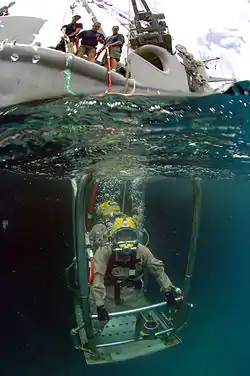Clearance diver
A clearance diver was originally a specialist naval diver who used explosives underwater to remove obstructions to make harbours and shipping channels safe to navigate, but later the term "clearance diver" was used to include other naval underwater work. Units of clearance divers were first formed during and after the Second World War to clear ports and harbours in the Mediterranean and Northern Europe of unexploded ordnance and shipwrecks and booby traps laid by the Germans.

_2_perform_diving_operations_to_raise_a_mine_off_the_ocean_floor_during_a_scenario_for_Frontier_Sentinel.jpg.webp)
In some navies, including Britain's Royal Navy (RN), work divers, which includes ship's divers, must have a line and a linesman when possible.
History
The first units were Royal Navy Mine and Bomb Disposal Units. They were succeeded by the "Port Clearance Parties" (P Parties). The first operations by P Parties included clearing away the debris of unexploded ammunition left during the Normandy Invasion. During World War II Navies used the heavy standard diving dress before upgrading to frogman-type gear.
Naval work diver training is much longer and harder than sport diver training and has much stricter entry requirements.[1]
Nations with naval work diving groups
_divers.jpg.webp)
Mainland Europe
- Estonia: EOD Tuukrigrupp (EOD Clearance Diver UNIT)Estonian Navy - mine countermeasures section
- France: The French Navy clearance divers are known as plongeurs démineurs.[2] The French Army also has clearance divers named plongeurs de combat du génie.[3] that operate in freshwater environments. Although they are trained in demolition and explosives clearance, they also survey banks and possible crossing areas.
- Germany: Minentaucher is Germany's Clearance Diver force[4]
- Ireland (Republic of): Naval Service Diving Section (NSDS) [5]
- Norway: Minedykkerkommandoen Norway's naval work divers and Clearance Diver force[6]
- Portugal: the Sapper Divers Group, which also serve as combat divers unit
- Sweden: Swedish Navy EOD division[7]
North America
- Canada: Canadian armed forces diversCanadian Department national defence policies Section 8009-0, Forces Diving
- US: Underwater Demolition Team - US Navy, 1943–1967
- Underwater Construction Teams US Navy, 1960’s - Present
Oceania
- Australia The Royal Australian Navy Clearance Diving Branch clearance divers also serve as combat divers[8]
- New Zealand The Royal New Zealand Navy Operational Diving Team (ODT) are clearance divers and also serve as combat divers[9]
United Kingdom
Royal Navy naval work divers are officially called Clearance Divers.[10] During WWII divers used the Davis Submerged Escape Apparatus, no wetsuit or swimfins.[11] On December 17, 1942, 6 Italians on three manned torpedoes attacked Gibraltar harbour. A British patrol boat killed the crew of one with a depth charge. Their bodies were recovered, their swimfins later used by Gibraltar's guard divers (Sydney Knowles and Commander Lionel Crabb). This was the first known British use of swimfins.
In 1944 November, following surrender of Italian forces an Italian frogman brought two Decima Flottiglia issue oxygen rebreathers, to Livorno, for the Allies to use. This equipment proved better than the Davis Apparatus and lasted longer on a dive he also brought a 2-piece frogman's drysuit. After the war and until the 1990s divers used the Siebe Gorman rebreather[12][13] and aqualung.
Training to become a Clearance Diver lasts around 7 months. Before trainees are accepted onto a course, they must pass a week-long diving aptitude selection, held at the Defence Diving School, on Horsea Island, Portsmouth. This selection involves passing the Divers Physical Fitness Test (DPFT), tests of physical and mental endurance and surface swimming. The candidates are also introduced to the Royal Navy's Swimmers Air Breathing Apparatus set and complete dives in Horsea lake, including night dives. Due to the physical and mental pressures brought on by military diving, the failure rate has been historically high. Owing to this, there is a three-day Pre Entry Diving Acquaint (PEDA), which allowed prospective candidates to undergo physical and mental tests to give them a better idea of the training.
The diving branch is formed of teams, that serve aboard mine hunters, perform domestic bomb, mine and IED disposal and the two Fleet Diving Groups (FDG).
- Expeditionary Diving Group (EDG). comes under 3 Commando Brigade specialising in Very Shallow Water (VSW) beach reconnaissance operations, working alongside UK Special Forces (UKSF). New members are trained in Parachuting, maritime counter-terrorism (MCT) tactics and Swimmer Delivery Vehicle (SDV) operations.[14].
- Tactical Diving Group (TDG) are the deep-water warfare unit who specialise in dealing with sea mines. Members will cross-train with EDG
Clearance divers have been involved in every major British conflict since their inception and have most recently deployed teams to Iraq, Afghanistan and Libya. They have units operating in the Persian Gulf and Indian Ocean providing an underwater Force Protection (UWFP) element. See Operation Kipion
See also
- United States military divers – Underwater divers employed by the US armed forces, including navy, army, marines, air force and coast guard
- Navy diver (United States Navy) – US Navy personnel qualified in underwater diving and salvage
- Underwater Construction Teams
- Explosive ordnance disposal (United States Navy) – US Navy personnel who render safe or detonate unexploded ordnance
- Frogman – Tactical scuba diver
References
- Navy EOD - Diver Training
- https://www.lemonde.fr/campus/article/2016/12/11/plongeurs-demineurs-l-elite-des-grands-fonds_5047083_4401467.html
- https://www.ladepeche.fr/article/2017/03/29/2545812-phase-tests-entrer-parmi-elite-plongeurs-combats-genie.html
- Prepare the way: German Navy mine divers
- Irish Defence Forces – Naval Service Diving Section (NSDS)]
- Norway's Naval divers and Clearance Diver force
- Siving division in Skredsvik, Sweden, Sailors & Officers trained as Naval divers.
- Australian clearance divers tasks include rendering and safe disposal of conventional ordnance and improvised explosive devices.
- New Zealand Navy Divers
- http://www.mcdoa.org.uk/RN_Clearance_Diving_Branch.htm
- pp 16-20, issue 41, Historical Diving Times.ISSN 1368-0390
- Quick, D. (1970). "A History Of Closed Circuit Oxygen Underwater Breathing Apparatus". Royal Australian Navy, School of Underwater Medicine. RANSUM-1-70. Archived from the original on 2008-05-09. Retrieved 2009-03-20.
- Goble, Steve (2003). "Rebreathers". South Pacific Underwater Medicine Society Journal. 33 (2): 98–102. Archived from the original on 2009-08-08. Retrieved 2009-03-20.
- Elite UK Forces - Fleet Diving Units